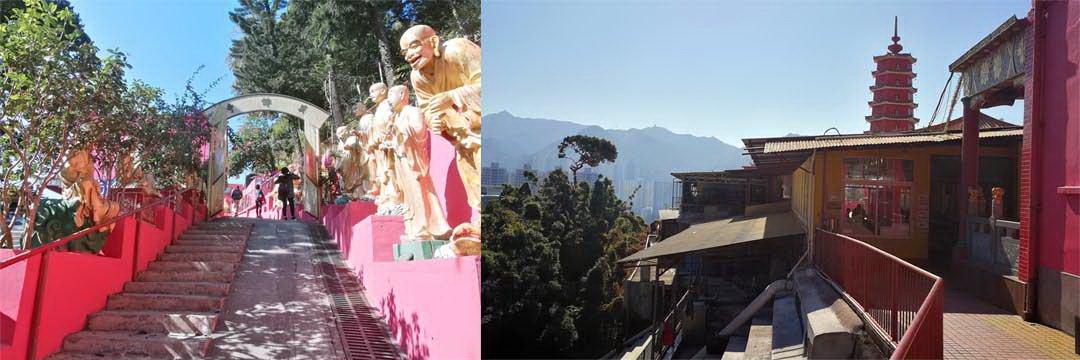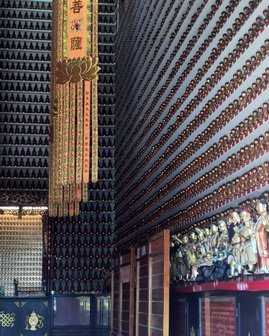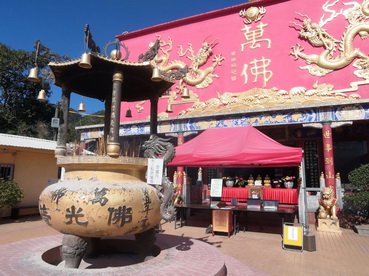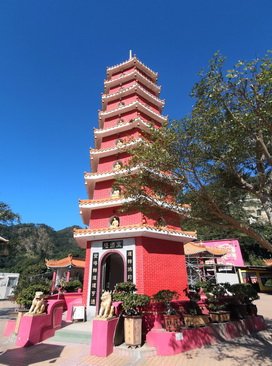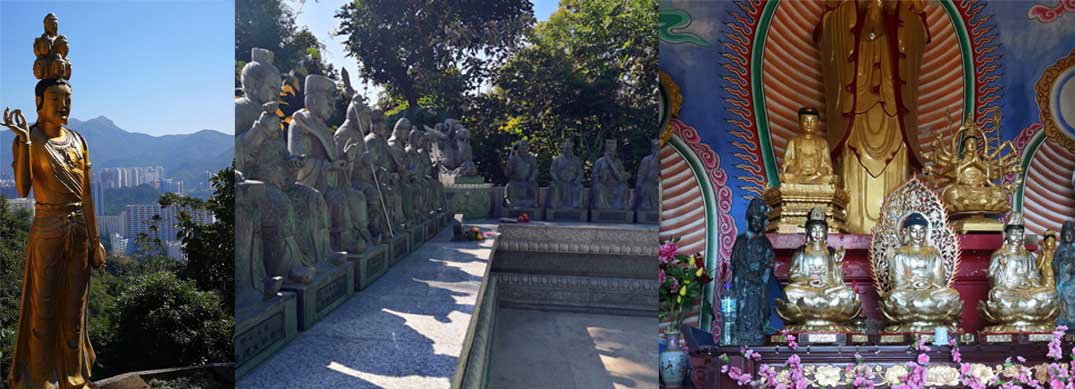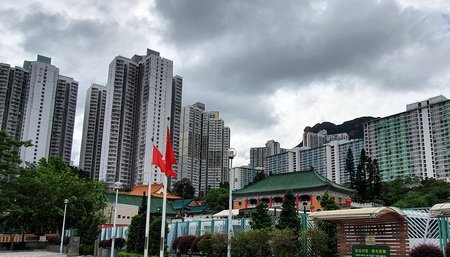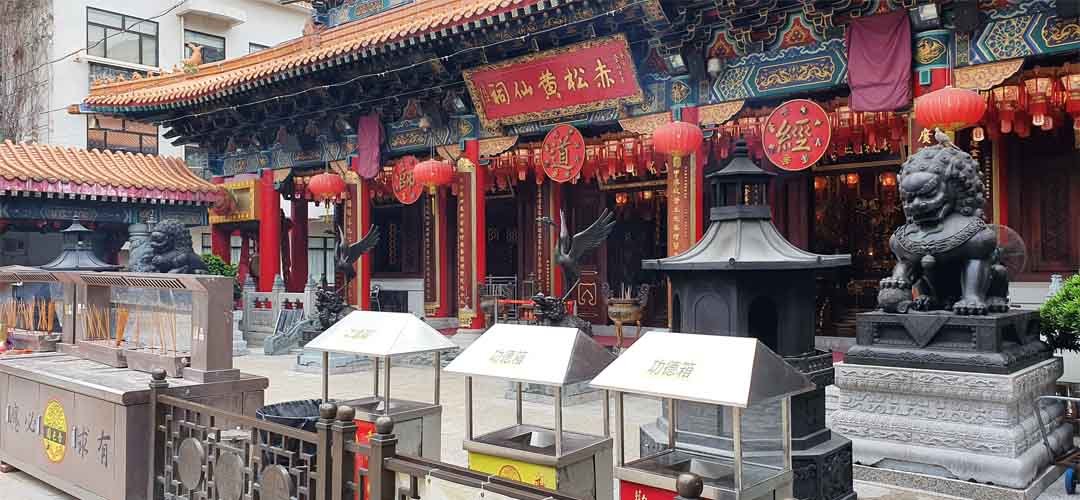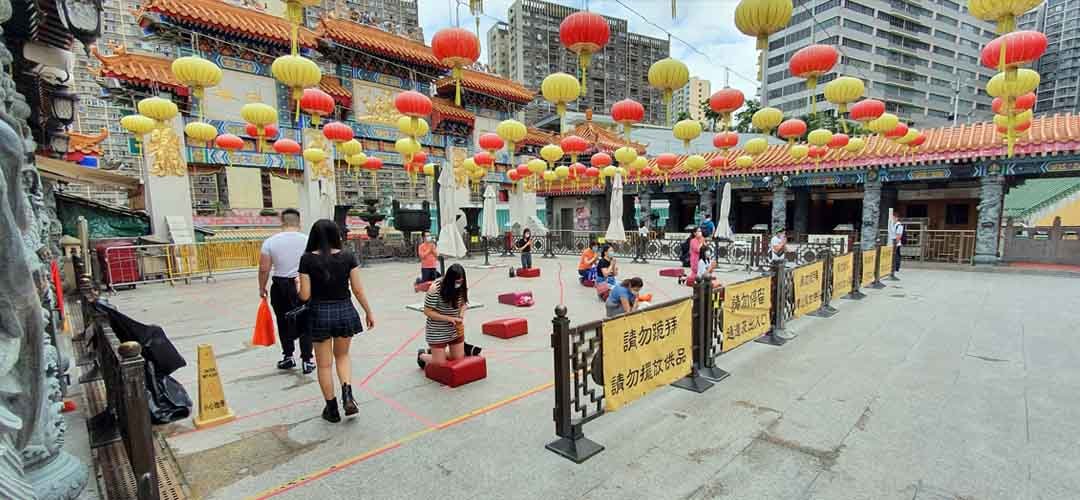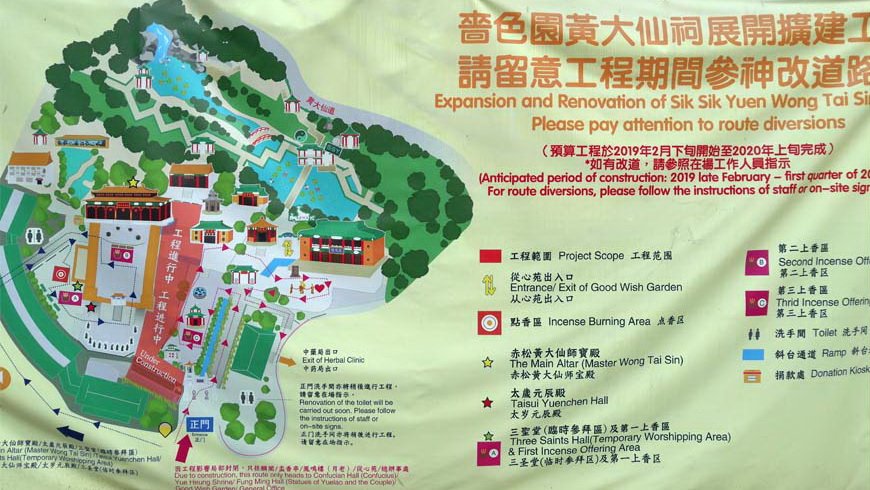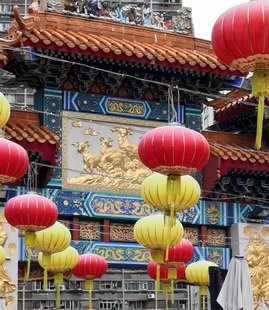Temples and Monasteries
The 10000 buddha monastery & Wong Tai sin temple
What will we talk about
Intro – 10000 Buddha Monastery – How to get there? – What to do there? – Practical information – Wong Tai Sin Temple – How to get there? – What to do there? – Practical information
C
oming to HK we enter a world different than Europe. One of its main characteristics is the lack of Christianity. It must be stated in general because it is not only about religion but about everything else it is connected to – the way people think, behave and dress, the places of worship, traditions, and souvenirs.
The beauty of this culture is a huge subject, and you can read more about it in the Stories from Hong Kong. Here, we will concentrate on the pure pleasure of a visit with some basic information about cultural differences.
Hong Kong has many places of worship. There can be a shrine covered in incense clouds everywhere you look. It is both a part of the belief in deities and the respect for the ancestors. Things you pass on the street – some fruit, smoke, and a figurine – they are a reminder and a prayer – it is so normal that after a while you stop noticing it.
But there are places where a tourist can feel 100% satisfied with the overwhelming effect of being inside a true, Asian temple. The Ten thousand Buddha or Po Lin Monasteries, the Wong Tai Sin, or Man Mo Temples are only the most notable examples. The Lantau Buddha is a whole day tour which will be described in another article. The Man Mo Temple will be a part of the Central Walk article. Therefore, we will concentrate on the other two here.
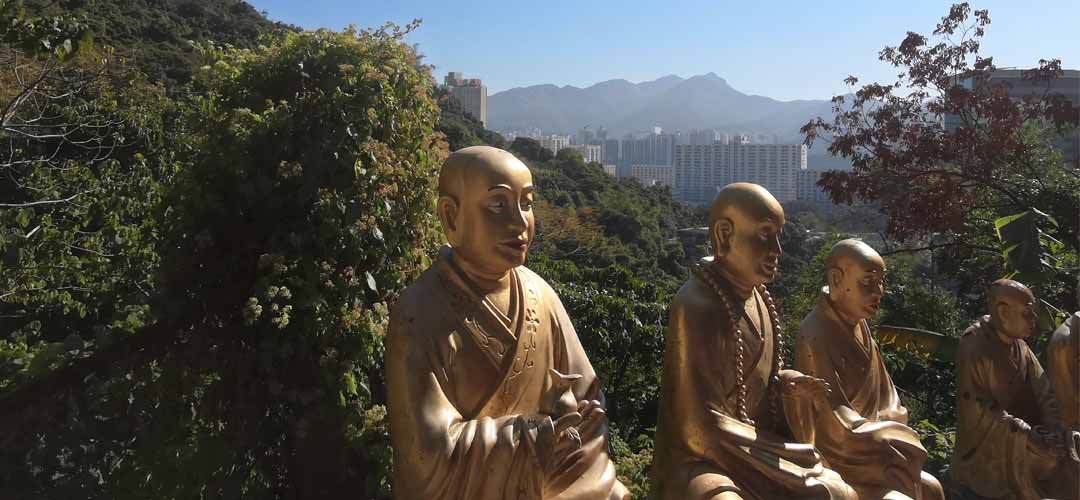
Ten Thousand Buddha Monastery…
…is located in Sha Tin. It is a stunning golden and red place, full of statues and great views. It is such a surprise that a place of such beauty and peace exists right next to the busy, modern town.
How to get there?
When you look at the map of Hong Kong you see its characteristic peninsula where the Kowloon District is located. Going north – you find a stretch of mountains – these are Kam Shan and Lion Rock County Parks. Then there are the New Territories that are a mixture of villages and green areas. It is all Hong Kong – but somehow less known among the tourists.
Sha Tin is just next to Kowloon – it is only the Lion Rock County Park that separates them. People like to live there since it is quieter and, at the same time, very close to the businesses from Kowloon and Hong Kong Island. If you are planning a visit to the Hong Kong Heritage Museum you are bound to come there.
The easiest way is the MTR’s light blue line, between the Hung Hom station and the Lok Ma Chau/Lo Wu terminus.
- You can try to get on the train on Hong Kong East MTR
- or interchange from the green line at Kowloon Tong MTR.
The stop you will be getting off is called SHA TIN STATION. Direct yourselves to the exit B (Home Centre/Grand Central Plaza/IKEA signs).
The train ride is not long. 20 minutes at the most.
Then – about a 15-minute walk to the start of the path leading to the monastery (photo to the left – the beginning of the path to the monastery). There is plenty of signs everywhere. Pedestrian bridges and pathways will lead you almost directly to it. The path to the monastery is behind it – you can put Sheung Wo Che Rd or Pai Tan St into an app and follow the GPS.
You will also see the monastery – so just go in its general direction (it is on a slope of a nearby hill).
There are bus connections (the bus terminus is just next to the MTR station) but the travel time is twice as long. As for the taxi – an example from Mong Kok MTR – 100 HKD and about 15-20-minute travel time.
What to do there?
The first thing to see is the path to the monastery. The concrete way behind the shopping center leads left into the green jungle and the bamboo groves. At some point you need to turn right – follow the correct signs, or else you will find yourself at a local cemetery (if you turn left). Then it starts (photos above)! A path turns into stairs, 430 of them, and each step is marked by a life-size statue of Buddha. Each one is different. It is not the same person – these are Arhat statues or simply put – the saints that have achieved enlightenment. The ultimate goal of Buddhism is to reach a point without any further suffering in life- it’s called Nirvana. Once you’ve done it you become a buddha, which is more of a title.
Have a good look at them. They are first of not 10 thousand but about 13000 statues you will find here. They are fascinating and give you a good reason to catch a breath on your way up. Beware of the fake monks – if you want to give money to anyone, do it at the temple.
Upon reaching the lower terrace you enter a place funded in 1949 by Reverend Yuet Kai. He built a complex consisting today of two parts – upper and lower with a few temples, pavilions, and a pagoda. The monk came from the South of China, he was a skilled lyre player and a teacher. He devoted his whole life to Buddhism, wanted to create a college but then started to build this temple. In this way, he honored his vow of sharing his philosophy with as many as he could. He died at the age of 87 and his body was post-mortem moved to the main temple of this Monastery. It is said it was well preserved giving him the aura of a Saint.
Many come here just to bow before him and ask for more miracles.
The main temple is the first building you encounter walking onto the lower terrace. You need to pass the souvenir shop and go to the “main square” to have a frontal view of it and see the entrance. You can go inside, but you should not take photos there. The temple walls are covered with small statues of Buddha – each one different. 3 bigger statues are displayed in the middle of this 10000 Buddha Hall. There is a lot of incense and souvenirs around them, notes with prayers, prayer wheels, places to kneel, and worship. In between the statues, there is a glass case with yet another, sitting Buddha covered in red cloth – this is a place where the final remains of Rev. Yueh Kai can be found.
The courtyard outside is covered with typical for the Buddhist temple elements. More statues and stories of the famous monk adorn it and its walls. The overwhelming smell of incense and special burners where you can stick them in, so they will slowly pray with you taking your intentions to the ears of the Buddha. The colors going from yellow to red, with marks of gold or an empty canvas of white. Even the live monkeys are a part of the decor -whether they are a symbol of “the monkey mind” that has to be overcome on the guardians against the evil spirits… they are a nice addition.
The pagoda cannot be missed there. It became a symbol of Hong Kong and its shape is depicted on some 100 HKD banknotes (2001 edition). There are 9 roofs there, which are divided by golden, sitting statues of Buddha. You can climb the stairs inside and get a glimpse of the surrounding area.
Apart from the Main Hall, Pagoda and monkeys there is more – a souvenir hall adorned with more Arhats from the outside, a pavilion with a white statue of the Goddess of Mercy (Kwun Yan), white elephant of Pu Xian (Lord of fire), blue lion of Wen Shu – they are all connected to sutras, various bodhisattvas and Buddhism in general.
From this terrace, you can go up. As you were entering before, you went left, but there was a path to the right. Another 70 steps there, all adorned with statues will take you to the upper part of the monastery. Some elements there were added recently, in 2009. This part has more pavilions and columbaria houses. The saints accompany the dead, whose remains either lie here or are mentioned here on a piece of a tablet. One columbarium has a gold, standing Buddha – after him, it was called Amitabha Hall. Kwun Yam House has a horseback bodhisattva and there is also a less impressive area of grey statues and stone tables (photo below). It is an ancestor place, where many come with offerings leaving fruit, prayers, and incense sticks. Find a small waterfall with a white statue of Kwun Yam, Goddess of Mercy, or more statues standing around and perched on the surrounding rocks… It is a place of meditation, remembrance, and peace. Take your time getting to know it.
 Practical information about 10000 Buddha Monastery:
Practical information about 10000 Buddha Monastery:
- admission between 9:00 -17:00 daily (free entrance)
- the tour of the place takes about 2 hours – you can visit the Hing Kong Museum of History, since you are already here, or return to other parts of the city
- the climb to the Monastery can be tiring, especially on a hot, damp day. Do not be in a hurry, rest and hydrate yourself
- some part of the edifice can be temporarily closed. It is constantly refurbishing
- the monastery can be dosed when there is heavy rainfall
- the monkeys are wild, not pets
- the second stairs leading down from the lower terrace have more statues and will take you to Sha Tin. But the path is less obvious, therefore not recommended
- at the foot of the hill, behind the shopping center there is Po Fook Hill Ancestral Hall. It is a completely different place, which can also be visited. The monks live and work here, and the monastery has no permanent residents- only caretakers.
Wong Tai Sin Temple
In between the streets, buildings and everyday business of Kowloon lies another place of worship. The local deity – Wong Tai Sin, heals and protects for over 100 years now. Master Wong was a mortal, according to the legend. A poor shepherd in IV century Eastern China. He was taught to cure by a fairy, dedicated his life to this craft, taught others the art of medicine and Taoism, and eventually became a god. He is responsible for many miracles.
The Taoist priests – Liang Renan and Liang Junzhuan brought his picture and story to Wan Chai in 1915. They set up a small medicine shop and a shrine and good things started to happen. In 1921 a divine guidance led them to a place at the feet of the Lion Mountain, not far from the Kowloon Bay. The fung shui was good there and it helped to create a perfect place of worship that you can visit today.
How to get there?
The temple is located at the A or B2 exits of the Wong Tai Sin MTR station. You just need to take the green metro.
As soon as you see the light of the day or emerge from the shopping center you will see a fence with some temple information. A massive, white arch will let you into the temple grounds of 18000 m2.
You leave the complex through the same gate or the fortune-tellers building. The arcade is not immediately visible when you exit the metro station – it is hidden slightly to the left. Both serve as entrances and exits, but sometimes, when there is a lot of tourists, there is only a one-way sightseeing path (just be aware it is possible).
What to do there?
Part of the Taoist religion is a belief in various deities. They were human once or they have more obscure and mythical beginnings. Therefore, there will be a few shrines in their name on the grounds of the temple complex.
What is more… the place was a private shrine until 1934. Then, it opened its doors to the public. It survived the Japanese occupation of HK – which is attributed as yet another miracle of Wong Tai sin. It also welcomed both Buddhism and Confucianism onto its grounds. From 1956 it is continually opened to the public. It even lived through the idea of the government building something in its place! And so, it stands among the tall, modern buildings showing a perfect coexistence of different yet similar, Asian beliefs.
Apart from the shrines, there will be a huge Confucian worshipping hall close to the white gate entrance (photos above). Medicine and education are attributes of the local patron. Until this very day, the Sik Sik Yuen initiative takes part in the life of the schools, clinics, and hospitals.
The second, great building of the area is more to the left. It is the Great Altar, containing the historic picture of Wong Tai Sin. You will not miss it – the smell of incense will lead you to it. Numerous worshippers kneel in front of it, ask the washing sticks for advice and leave their prayers alongside their offerings. The wishing sticks are an old I-Ching tradition. You pray, you ask, you shake the box until one stick falls out. You can then read a soothsayer or take your stick to the fortune-teller arcade (photos below).
The temple is magnificent, guarded by the shadow of the Lion Mountain and lion sculptures. It is covered with inscriptions, which make intricate ornamentation in blue, red, and gold. Every part of the yellow-tiled roof seems to be underlined by some decoration. And the last detail is the lanterns hanging over the worshippers’ heads. The atmosphere is special, gives you a feeling of reality mixed with legends.
The Pai-Fong gateway takes you a few steps down to the lower platform (photo below). There are 12 figures of the Chinese Zodiac (bronze rat statue below in photo) waiting for you. To the right, you will find the incense offering area. You can buy your offerings there. It is just next to the fortune-teller’s arcade. The stairs close to the Rat Zodiac lead down to the Tai Sui Yuenchen Hall. This is the 2011 addition. It is an underground, hi-tech worship area. The entrance cost 100 HKD. Offerings inside are electronic and require payment as well – for only 300HKD you put your paper – prayer into a box, the machine accepts the offering with artificial smoke and lights. It is an expensive, 100 million dollars, full of gold and LED lights project… There is also an artificial dome with the sky inside, but whether all of it brings a prayer faster to the ear of the gods remains an open question.
Profit from the sights that the temple complex has to offer. All the shrines are built in the traditional, Chinese architecture style. You can look for more peace and quiet in the adjacent gardens called the Good Wish Gardens. There are more pavilions, pagodas, bridges, streams and feng shui spirit there. Some things resemble the Summer Palace in Beijing – there is even a replica of the Nine Dragons Wall. The sheep statue is a gift from Zhejiang Province – where Wong Tai Sin was born. It is connected to one of the early miracles he made as a young man. He changed white boulders into sheep his brother was looking for.
There are some worship rules, which advise to bring only 9 incense sticks and leave 3 at each worship place – at the Main Altar, Three Saints Hall and Yue Hung Shrine (Incense offering areas are marked on a map as A, B, C). There are simply too many people (hence the creation of the electronic offering space). What is more, Wong Tai Sin listens to the sick and people with problems, both subjects that always invoke a prayer. We all know that a problem and stress is our forever companion the XXI century. This makes the Temple very popular.
 Practical information about Wong Tai Sin Temple:
Practical information about Wong Tai Sin Temple:
- free admission from 9:00 – 17:00
- the only payment of 100 HKD is to the Tai Sui Yuenchen Hall
- on the Chinese New Year’s Eve, it is open throughout the night
- the visit will take you about 1,5 hours at the most. Mong Kok is not far from here, you can organize your day accordingly
- when there are too many visitors a one-way worship path can be organized. Now, in 2020 there are also some refurbishment works, so please read the signs to know where to go and what may be closed.
- be careful with fortune-tellers. The price starts with 100 HKD, but foreigners tend to be charged much, much more.


